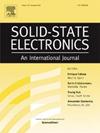Comprehensive analysis of MOSFET threshold voltage extraction method considering DIBL effect from 300 K down to 10 K
IF 1.4
4区 物理与天体物理
Q3 ENGINEERING, ELECTRICAL & ELECTRONIC
引用次数: 0
Abstract
It is well known that different threshold voltage (Vth) extraction methods exhibit inconsistencies with respect to different drain voltage (Vd). This inconsistency becomes disruptive when temperature is considered for cryogenic applications such as quantum computing. This investigation examines various Vth extraction methods from room down to cryogenic temperatures, with a particular emphasis on how different Vd values combined with extraction methods behave as temperature decreases. For the first time, we find that the square root Id method maintains consistency regardless of Vd, from 300 K all the way down to 10 K is identified. This provides a good insight into how the Drain-Induced Barrier Lowering (DIBL) effect changes with temperature, and positions the square root Id method as a reliable tool for Vth extraction in cryogenic temperature.
综合分析考虑DIBL效应的MOSFET阈值电压提取方法,从300 K降至10 K
众所周知,不同的阈值电压(Vth)提取方法对于不同的漏极电压(Vd)表现出不一致性。当考虑低温应用(如量子计算)的温度时,这种不一致性就变得具有破坏性。本研究考察了从室温到低温的各种Vth提取方法,特别强调了不同Vd值结合提取方法在温度降低时的表现。我们第一次发现,无论Vd如何,平方根Id方法都保持一致性,从300 K一直到10 K都是确定的。这为漏极诱导势阱降低(DIBL)效应如何随温度变化提供了很好的见解,并将平方根Id方法定位为低温条件下Vth提取的可靠工具。
本文章由计算机程序翻译,如有差异,请以英文原文为准。
求助全文
约1分钟内获得全文
求助全文
来源期刊

Solid-state Electronics
物理-工程:电子与电气
CiteScore
3.00
自引率
5.90%
发文量
212
审稿时长
3 months
期刊介绍:
It is the aim of this journal to bring together in one publication outstanding papers reporting new and original work in the following areas: (1) applications of solid-state physics and technology to electronics and optoelectronics, including theory and device design; (2) optical, electrical, morphological characterization techniques and parameter extraction of devices; (3) fabrication of semiconductor devices, and also device-related materials growth, measurement and evaluation; (4) the physics and modeling of submicron and nanoscale microelectronic and optoelectronic devices, including processing, measurement, and performance evaluation; (5) applications of numerical methods to the modeling and simulation of solid-state devices and processes; and (6) nanoscale electronic and optoelectronic devices, photovoltaics, sensors, and MEMS based on semiconductor and alternative electronic materials; (7) synthesis and electrooptical properties of materials for novel devices.
 求助内容:
求助内容: 应助结果提醒方式:
应助结果提醒方式:


